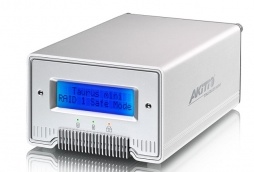If you’re an audio/video enthusiast (and who isn’t these days?), Akitio’s (http://www.akitio.com/) Taurus Mini Super-S provides an easy-to-use, reasonably priced (US$199), 2.5-inch, dual bay SATA enclosure, compact in size, which is complete with a built-in LCD display and two FW800 ports for daisy chaining.
Extremely flexible, the Taurus Mini Super-S sports eSATA, FireWire 800 and USB 2.0 connectivity and is compatible with Mac OS X 10.4 or higher. It worked just fine with OS X 10.7 (“Lion”) in my experiments.
To maximize performance and data throughput, the Taurus Mini Super-S supports “RAID 0-Striping,” a solution for daily backups and other data transfers. In addition, the “RAID 1-Mirroring” function will automatically create a copy of all data in the event a drive may fail.
In RAID-O-Striping, the drives are shown as one large single volume but the total size will depend on the drive with the smallest capacity. This setting is used where speed is the primary objective but RAID Level 0 (also called striping) isn’t redundant. This form of array splits each piece of data across the drives in segments; since data is written without any form of parity data-checking, it allows for the fastest data transfer. On the downside, if one drive becomes damaged, the whole array can become corrupted.
In RAID 1, DISK Mirroring, two drives show up as one volume but only 50% of the total capacity, depending on the drive with the smallest capacity, can be used. RAID 1 creates an exact copy (or mirror) of a set of data on the second drive. This is useful when reliability and backup take precedence over storage capacity. If one hard drive bites the dust, it can be replaced and the data rebuilt automatically.
The Taurus Mini Super-S works with two 2.5-inch SATA-I or SATA-II hard drives (1.5GB/second or 3.0GB/second) with heights of 9.5 or 12.5mm. It’s best if you use hard drives of identical capacities.
Set-up is relatively easy. The RAID mode should be set after installing the drives and before first formatting the drives. Make sure the power is off and then install the hard drives. Unlock the RAID switch on the rear of the device. Connect the power supply to the device and then plug it into the power outlet to turn the device on.
Enter the setup menu and set your preferred RAID mode. The system will restart and ask for confirmation.
Changing the RAID mode requires you to re-format the drives. This will erase all data on the hard drives that are being formatted, so be sure to backup all existing data.
Akitio’s storage solution comes equipped with a built-in LCD display for device configuration, event messages and access to detailed information about the external hard drives. That’s a nice, user friendly touch. Parameters, such as HDD temperature, can be monitored with the help of the LCD display. Also, the storage device utilizes Self-Monitoring, Analysis and Reporting Technology to obtain data directly from the HDD.
Akitio’s product is designed for two hard drives and doesn’t work with only one installed. Of course, if you were only going to use one, why would you buy the Taurus Mini Super-S in the first place. Support for Thunderbolt would be nice, but you can’t have everything.
Rating: 8 out of 10
— Dennis Sellers




